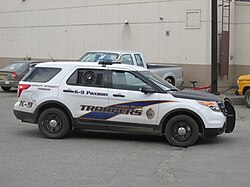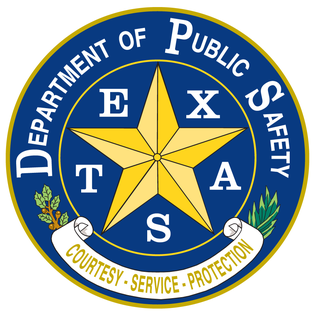
The Department of Public Safety of the State of Texas, commonly known as the Texas Department of Public Safety (DPS), is a department of the state government of Texas. The DPS is responsible for statewide law enforcement and driver license administration. The Public Safety Commission oversees the DPS. However, under state law, the Governor of Texas may assume command of the department during a public disaster, riot, insurrection, formation of a dangerous resistance to enforcement of law, or to perform his constitutional duty to enforce law. The commission's five members are appointed by the governor and confirmed by the Texas Senate, to serve without pay for staggered, six-year terms. The commission formulates plans and policies for enforcing criminal, traffic and safety laws, preventing and detecting crime, apprehending law violators, and educating citizens about laws and public safety.

The West Virginia State Police (WVSP) is a state law enforcement agency in the United States that provides police services to the residents of West Virginia. It is the fourth-oldest state police agency in the US. The WVSP was disbanded due to their involvement in quelling of the uprisings on behalf of the coal and mine companies which were surrounding the concept of organized labor in the coal and mine industries. The WVSP was then reorganized as the Department of Public Safety in the second extraordinary session of the West Virginia Legislature on June 19, 1919, as a result of their involvement.

The Michigan State Police (MSP) is the state police agency for the U.S. state of Michigan. The MSP is a full-service law enforcement agency, with its sworn members having full police powers statewide.
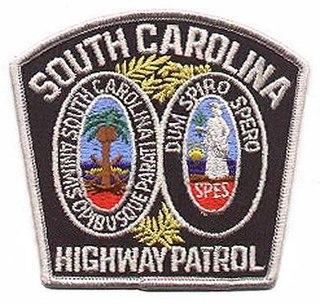
The South Carolina Highway Patrol is the highway patrol agency for South Carolina, which has jurisdiction anywhere in the state except for federal or military installations. The Highway Patrol was created in 1930 and is an organization with a rank structure similar to the armed forces. The mission of the South Carolina Highway Patrol includes enforcing the rules and regulations in order to ensure road way safety and reducing crime as outlined by South Carolina law. The Highway Patrol is the largest division of the South Carolina Department of Public Safety and its headquarters is located in Blythewood. This department also includes the South Carolina State Transport Police Division, and the South Carolina Bureau of Protective Services.
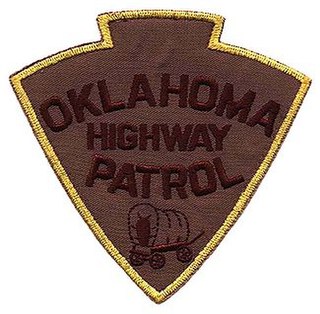
The Oklahoma Highway Patrol (OHP) is a major state law enforcement agency of the government of Oklahoma. A division of the Oklahoma Department of Public Safety, the OHP has traffic enforcement jurisdiction throughout the state. OHP was legislatively created on July 1, 1937, due to the growing problem of motor vehicle collisions, the expansion of highway systems, and the increase in criminal activities.

The Colorado State Patrol(CSP) (originally known as the Colorado State Highway Courtesy Patrol), based in Lakewood, Colorado, is a division of the Colorado Department of Public Safety, and is one of the official state patrol agencies of Colorado, along with the Colorado Bureau of Investigation (CBI), Colorado Division of Criminal Justice (DCJ), Colorado Division of Fire Prevention & Control (DFPC), and Colorado Division of Homeland Security and Emergency Management (DHSEM). Additionally, the Executive Director's Office supports operations of the five divisions and houses the Colorado School Safety Resource Center (CSSRC) and Colorado Integrated Criminal Justice Information Systems (CJIS). The CSP primarily enforces traffic laws on interstates and state highways and guards the state capitol and the Governor of Colorado.

The Arizona Department of Public Safety (AZDPS) or Arizona Highway Patrol (AHP) is a state-level law enforcement agency with a primary function of patrolling and enforcing state laws on Arizona highways. Their headquarters are in Phoenix.

The Texas Highway Patrol is a division of the Texas Department of Public Safety and is the largest state-level law enforcement agency in the U.S. state of Texas. The patrol's primary duties are enforcement of state traffic laws and commercial vehicle regulation, but it is a fully empowered police agency with authority to enforce criminal law anywhere in the state. Highway patrol troopers are also responsible for patrolling the state Capitol Complex in Austin and providing security to the governor. The current Chief is Lieutenant Colonel Dwight Mathis.

The Georgia State Patrol (GSP) was established in March 1937 in the U.S. state of Georgia and is a division of the Georgia Department of Public Safety. It is the primary state patrol agency for the U.S. state of Georgia. Although focused primarily on the enforcement of traffic laws and investigation of traffic crashes, the Georgia State Patrol (GSP) supports the efforts of all public safety agencies to reduce criminal activity, apprehend those involved, and respond to natural and manmade disasters.

The Mississippi Highway Patrol is the highway patrol and acting state police agency for the U.S. state of Mississippi, and has law enforcement jurisdiction over the majority of the state.
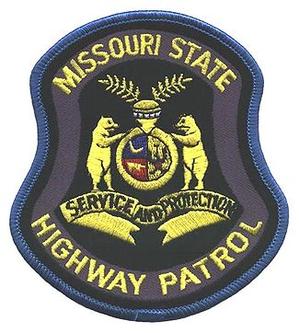
The Missouri State Highway Patrol(MSHP) is the highway patrol agency for Missouri and has jurisdiction all across the state. It is a division of the Missouri Department of Public Safety. Colonel Eric T. Olson has been serving as the 24th superintendent since March 15, 2019.
The Alaska State Trooper Academy is located in Sitka, Alaska, and trains Alaska State Troopers as well as other types of law enforcement personnel. It is technically known as the Alaska Department of Public Safety Training Academy and also the DPS Academy. In addition to state troopers, it trains municipal police officers, state park rangers, fire marshals, and Village public safety officers (VPSOs).

Trooper is a rank used by several civilian state law enforcement organizations in the United States. In its plural form, state troopers, it generally refers to sworn members of a state law enforcement agency, state police, state highway patrol, or state department of public safety, even though those officers may not necessarily be of the rank of trooper.
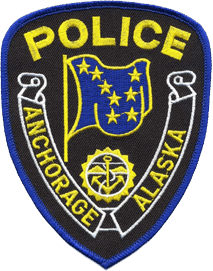
The Anchorage Police Department (APD) is the police department of the Municipality of Anchorage in Alaska. Functioning as a service area of the Municipality, its patrol area includes the core "Anchorage bowl", the Seward Highway corridor from Potter Creek south to McHugh Creek, and the Glenn Highway corridor north of the Anchorage bowl to the municipality's border with the Matanuska-Susitna Borough, including the communities of Eagle River, Chugiak and Eklutna. Through a memorandum of understanding, APD also handles calls on Joint Base Elmendorf-Richardson which involve civilian suspects or victims. Serving Alaska's largest city, APD is also the only metropolitan agency and the largest municipal police force in Alaska.
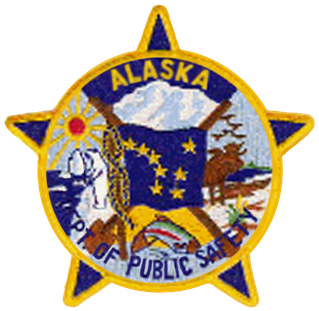
The Alaska Department of Public Safety is a law enforcement agency with its usual focus being the protection of life, property and wildlife resources in the state of Alaska in the United States.
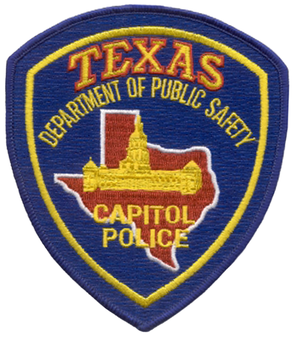
The Texas Capitol Police provide law enforcement and security for state property within the Texas Capitol Complex. The Department of Public Safety assumed the responsibilities of the Capitol Police by legislative mandate in 1991. The previous Capitol Police department was a division of the State Purchasing and General Services Commission. The first DPS Capitol Police recruits graduated from the Training Academy in 1993. The first Capitol Police officers commissioned by DPS were not given the full recruit school training that Highway Patrol recruits received and were not initially eligible to transfer outside of the Capitol Police without first attending a DPS Recruit Academy. This has changed and DPS Capitol is now considered a DPS Region that troopers transfer in and out of in comparison to other regions.

In the United States, the state police is a police body unique to each U.S. state, having statewide authority to conduct law enforcement activities and criminal investigations. In general, state police officers or highway patrol officers, known as state troopers, perform functions that do not fall within the jurisdiction of the county sheriff, such as enforcing traffic laws on state highways and interstate expressways, overseeing the security of the state capitol complex, protecting the governor, training new officers for local police forces too small to operate an academy and providing technological and scientific services. They support local police and help to coordinate multi-jurisdictional task force activity in serious or complicated cases in those states that grant full police powers statewide.

Alaska State Troopers is an American documentary television series that airs on National Geographic Channel and premiered on October 14, 2009. It is narrated by Marc Graue. The show follows the daily beats of various bureaus within the Alaska State Troopers. In addition, the show features segments that follow village public safety officers from small rural villages as well as officers from other cities such as Wasilla, Palmer, Anchorage, and Soldotna.














